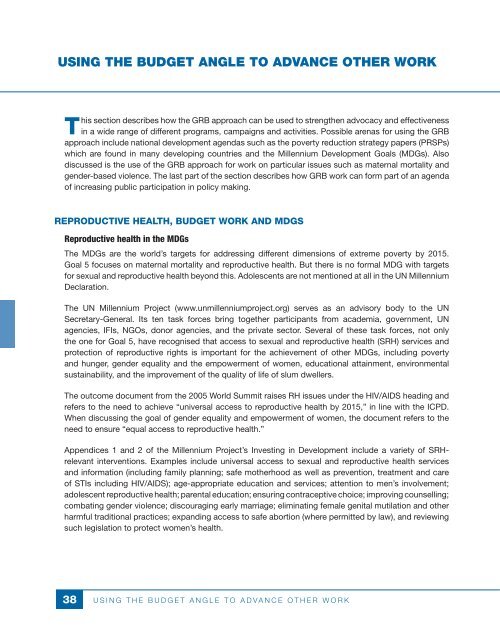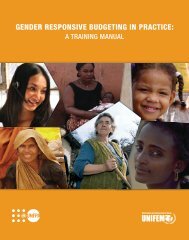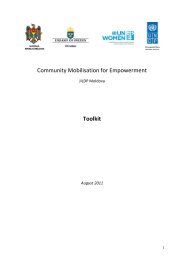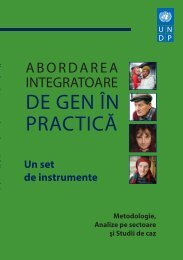Gender Responsive Budgeting and Women's Reproductive Rights ...
Gender Responsive Budgeting and Women's Reproductive Rights ...
Gender Responsive Budgeting and Women's Reproductive Rights ...
Create successful ePaper yourself
Turn your PDF publications into a flip-book with our unique Google optimized e-Paper software.
Using the budget angle to advance other workThis section describes how the GRB approach can be used to strengthen advocacy <strong>and</strong> effectivenessin a wide range of different programs, campaigns <strong>and</strong> activities. Possible arenas for using the GRBapproach include national development agendas such as the poverty reduction strategy papers (PRSPs)which are found in many developing countries <strong>and</strong> the Millennium Development Goals (MDGs). Alsodiscussed is the use of the GRB approach for work on particular issues such as maternal mortality <strong>and</strong>gender-based violence. The last part of the section describes how GRB work can form part of an agendaof increasing public participation in policy making.<strong>Reproductive</strong> health, budget work <strong>and</strong> MDGs<strong>Reproductive</strong> health in the MDGsThe MDGs are the world’s targets for addressing different dimensions of extreme poverty by 2015.Goal 5 focuses on maternal mortality <strong>and</strong> reproductive health. But there is no formal MDG with targets .for sexual <strong>and</strong> reproductive health beyond this. Adolescents are not mentioned at all in the UN MillenniumDeclaration.The UN Millennium Project (www.unmillenniumproject.org) serves as an advisory body to the UNSecretary-General. Its ten task forces bring together participants from academia, government, UNagencies, IFIs, NGOs, donor agencies, <strong>and</strong> the private sector. Several of these task forces, not onlythe one for Goal 5, have recognised that access to sexual <strong>and</strong> reproductive health (SRH) services <strong>and</strong>protection of reproductive rights is important for the achievement of other MDGs, including poverty<strong>and</strong> hunger, gender equality <strong>and</strong> the empowerment of women, educational attainment, environmentalsustainability, <strong>and</strong> the improvement of the quality of life of slum dwellers.The outcome document from the 2005 World Summit raises RH issues under the HIV/AIDS heading <strong>and</strong>refers to the need to achieve “universal access to reproductive health by 2015,” in line with the ICPD.When discussing the goal of gender equality <strong>and</strong> empowerment of women, the document refers to theneed to ensure “equal access to reproductive health.”Appendices 1 <strong>and</strong> 2 of the Millennium Project’s Investing in Development include a variety of SRHrelevantinterventions. Examples include universal access to sexual <strong>and</strong> reproductive health services<strong>and</strong> information (including family planning; safe motherhood as well as prevention, treatment <strong>and</strong> careof STIs including HIV/AIDS); age-appropriate education <strong>and</strong> services; attention to men’s involvement;adolescent reproductive health; parental education; ensuring contraceptive choice; improving counselling;combating gender violence; discouraging early marriage; eliminating female genital mutilation <strong>and</strong> otherharmful traditional practices; exp<strong>and</strong>ing access to safe abortion (where permitted by law), <strong>and</strong> reviewingsuch legislation to protect women’s health.38U s i n g t h e b u d g e t a n g l e t o a d v a n c e o t h e r w o r k





